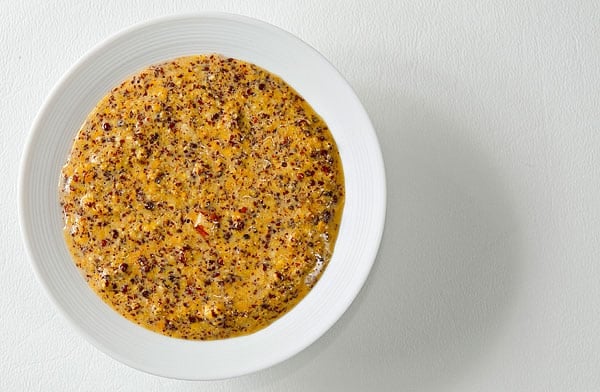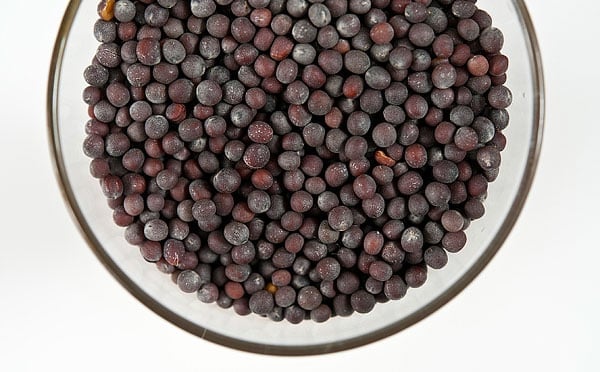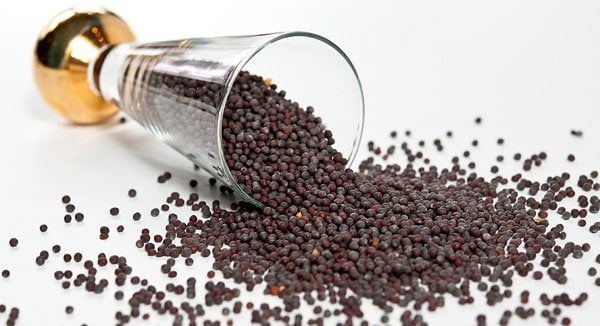As an Amazon Associate I earn from qualifying purchases.

What do you mean you can make mustard at home? It was all I could do to say, “Uh… how did you think it was made? By mustard elves under a tree?” Thankfully, I am older and nicer than I once was. Instead, I said, “Why yes, and it is really, really easy to make.”
I had this conversation with another food blogger, and I tell you this because even for even a food person to not know how to make mustard tells me that it must appear to be magic to most people. But I gotta tell ya folks, it ain’t. If you have mustard seed and water, you can make mustard. It’s that easy. And pretty much every culture in the Northern Hemisphere has done so: Mustard is to the North what chiles are to the tropics.
Mustard is a condiment of a thousand faces. Some are smooth, others almost entirely made from barely cracked seeds. Vinegar is often used, but wine, beer, grape must, and even fruit juices are used to moisten the seeds. Sweetness is usually achieved by adding honey; an American “honey mustard” can be a 1:1 ratio of mustard to honey. A Bavarian sweet mustard, however, uses only sugar and water: no acid, no honey. Italians put fruit preserves in their mustard, a practice I wholeheartedly endorse.
Mustard is one of Europe’s few native spices, although mustard also has been used in Chinese cooking for around 2,500 years as well. Ancient Rome was quite the hotbed of mustard-making, and it is Rome that gives us our name for mustard: It is a contraction of mustum ardens, or “hot must;” the Romans often added crushed mustard seeds to unfermented crushed grapes. I’ve recreated a different Roman recipe for mustard that uses almonds, pine nuts, mustard seed and red wine vinegar. The ferocious bite of this mustard — it should be made with black mustard seeds, the hottest variety — is mellowed by the richness of the nuts. It’s a great accompaniment to roasted meats.
The basic idea behind making mustard is this: Grind seeds and add cool liquid. At its most basic, this is all mustard is. Both Chinese and English mustard (think Coleman’s) is nothing more than water and mustard powder. But there are some things you need to know to make great mustard.
First, you need cold liquid. What gives mustard its bite is a chemical inside the seeds reacting with cool or cold liquid. You also need to break the seeds to get at the fiery chemical — it’s like cutting an onion. Heat damages this reaction, however, so to make a hot mustard use cold water, and warm water for a more mellow mustard. Mustard sauces lose punch when long-cooked, and should always have a little extra fresh mustard tossed in at the end of cooking.
This reaction is volatile, too. Left alone, your mustard will lose its bite in a few days, or in some cases even hours. But adding an acid, most often vinegar, stops and sets the reaction in place — this is precisely what happens with horseradish as well. Adding salt not only improves the flavor, but also helps preserve the mustard, too.
Once made, mustard is nearly invulnerable to deterioration. Mustard is one of the more powerful anti-microbial plants we know of, and, considering it is mixed with vinegar and salt, it becomes a heady mix no wee beastie can survive in. It is said that mustard will never go bad, although it can dry out.
You have three choices when it comes to which variety of mustard seed you use: White, brown and black. White mustard undergoes a different, milder reaction than do brown or black mustards, which are far zingier. American yellow mustard is made with white mustard seed and turmeric, brown mustards are in most of your better mustards, and black mustard is used in hot mustards or in Indian cuisine.

Incidentally, the wild mustard all over California is black mustard. You can thank Father Junipero Serra for that one: He used mustard, which grows like a weed, to mark his travels in Alta California 250 years ago.
The famous Grey Poupon mustard — Dijon has been a center of mustard-making for nearly a millennia now — is traditionally made with stone ground brown mustard and verjus, the tart juice of unripe grapes. I prefer this style of mustard, and most of my homemade mustards are grainy like Dijon. I grind my seeds with a spice grinder, but you could get all old school and use a mortar and pestle.
The best mustards, in my opinion, combine brown or black mustard seeds with yellow mustard powder: The two sets of chemical reactions complement each other and made a more complex mustard.
Always add water or a non-acidic liquid first, let the mixture sit for 10 minutes or so, then add the acid (vinegar, verjus, lemon juice, etc).
Add salt to taste, but it’s typically about 1 to 2 teaspoons per cup of prepared mustard.
Finally, let your mustard set in the fridge or in a cool place for at least a day before you serve it. Bitterness is a byproduct of the mustard reaction, but that bitterness fades after a day or so. Pure mustards can be kept at room temperature, but mustards with other ingredients, like the Roman nut mustard I mention above, should be kept in the fridge.
So there you have it. Easy-peasy. Now you really have no reason to ever buy mustard again.

[recipe_name]Basic Country Mustard[/recipe_name]
[summary]What could be easier than making your own mustard? No, really. It is stupid easy. Grind some mustard seeds, mix with mustard powder and some liquid and you’re done. There is no earthly reason to ever buy mustard once you learn this basic recipe. Endless variations exist. Change the liquid and you change the mustard. Grind the mustard seeds a lot or a little and you change the texture — or skip the whole seeds altogether and use just mustard powder.
Which type of mustard seed do you use? Yellow is what we Americans are most used to, but brown is spicier, more mustardy. Black mustard is stronger still, and it grows wild over much of North America; gather the seeds in late summer or early fall.
Want herbs in there? Go for it. Like honey mustard? Pour some in. Want your mustard even spicier? Add chiles or freshly grated horseradish. I even made a mustard with fresh grape juice from my backyard wine grapes. I called it Deep Purple. Weird-looking, but delicious.
The one caveat to making mustard at home is to wait. You cannot eat it the day you make it. Mustard needs to marinate to dissipate its bitterness. Try it: Eat a little dab right after you make it, then a day or two later. The difference is dramatic.[/summary]
[yield]Makes about 1 cup.[/yield]
Prep Time:[preptime time=12H] 12 hours[/preptime]
- [ingredient][amount]6 tablespoons[/amount] [item]mustard seeds[/item] [/ingredient]
- [ingredient][amount]1/2 cup[/amount] [item]mustard powder[/item] [/ingredient]
- [ingredient][amount]3 tablespoons[/amount] [item]vinegar[/item] (cider, white wine or sherry) [/ingredient]
- [ingredient][amount]1/2 cup[/amount] [item]white wine[/item] or water [/ingredient]
- [ingredient][amount]2 teaspoons[/amount] [item]salt[/item] [/ingredient]
OPTIONAL
- [ingredient][amount]2 tablespoons[/amount] [item]honey[/item] [/ingredient]
- [ingredient][amount]2 tablespoons[/amount] grated [item]fresh horseradish[/item] [/ingredient]
- 1/4 cup minced fresh herbs (really any kind)
[instructions]
- Grind the whole mustard seeds for a few seconds in a spice or coffee grinder, or by hand with a mortar and pestle. You want them mostly whole because you are using mustard powder, too.
- Pour the semi-ground seeds into a bowl and add the salt and mustard powder. If using, add one of the optional ingredients, too.
- Pour in the vinegar and wine or water, then stir well. When everything is incorporated, pour into a glass jar and store in the fridge. Wait at least 12 hours before using. Mustard made this way will last a year in the fridge.
[/instructions]




how is this for bad-a**. I just grew my own mustard plants, harvested the seeds and made my mustard from those. Beat that DIYers.
b
when do you gather wild mustard, and do you have to hang and dry it
One way to knock down the bitterness of the black/brown mustard seed
is to soak in water for 24 to 48 hours before grinding.
This is what I did with my last batch. I used 1/4 cup black, 1/4
cup brown, 1/4 cup white seed. soaked the lot over night.
Drained then added a 1/4 cup Colmand’s powdered mustard, blended
with cold water, salt, vinegar, honey and a cinnamon leaf.
It was a bit rough coming out of the shoot but it will mellow.
I need to cook with low sodium recipes. How important is the salt in mustard? Can I leave it out, and/or substitute some herbs? Any recommendations?
Also, if I pick some fresh mustard, do I just use the flowers? I live in California, it’s everywhere. And, how important is the mustard powder – would crushed fresh work as well?
Think I’ll grow a little in my garden this year, be sure no pesticides mess it up.
Thanks very much, and for your having site, as well.
Helen
Mark: It will mellow over time. But on the next batch, use warm water instead of cold. The mustard will be milder.
I made your recipe and the resulting mustard is brutally hot and bitter, two weeks after aging in the fridge. Any suggestions on how to save this batch?
Could you make your own mustard powder by grinding some mustards seeds?
This made me remember my gran making horseradish on the farm, and my dad always making mustard at home all the while showing me and telling me how he learnt it from his mom. I think it is time for me to continue the tradition. Thanks for a great post.
Extremely well written and informative post Hank! The other consideration with the bitter flavor is that not all mustard seeds are created equal. I own a small mustard company and when we source our seeds we get dozens of samples, all tasting slightly different from each other. Best of luck with your mustard making endeavors!
I am in love with mustard. I have gotten my youngest sister addicted as well. I figured, what could be the best gift for her besides some real, homemade mustard. Then I started thinking of all of the possibilities of variation! She hates spicy, I LOVE spicy. So thank you for the inspiration to make your own mustard! You get another level of satisfaction consuming it, knowing exactly what went into it. I know I’ll never buy store bought mustard again…now I need to convince my little sister. Thanks!!!
Thank you so much for this great article! I love mustard and have made it at home a few times already, but always from recipes. This helped me understand the process a bit more, what vinegar does, why the cold liquid, etc. I’ll be making up my own recipe next time!
Your recipe does not indicate an amount of time to wait after mixing the mustard seed with water / wine / or something else. If I understand correctly, the acid (vinegar, lemon juice, etc) will stop the decline of the heat of the mustard that occurs after the mustard and liquid are mixed. True?
After that, the storage in the refrigerator for days to weeks is to get rid of a bitter taste not to wait for the heat to diminish. Is this true.
If the mustard is very bitter at the beginning, how do you get a feel for how hot it is as a function of time so you know when to add the acid?
Thanks for all of this information. I just finished a mustard I LOVE; combining some bing cherries and port wine with yellow and brown mustard seeds and it is terrific. Then someone told me I should not veer off course from standard recipes (what fun is that?), that I should test the PH, definitely needed to process it in a hot water bath and more. Made me worry I would kill someone with my creation even though I went into it confident I had taken steps to not let that happen!
I had done enough research to not want to can it because of the negative association with heat and I’m so grateful to read that you concur. Of course I plan to refrigerate it but will now go eat a spoonful and rest easy. 🙂
I guess what I’m saying is thank you for letting me know I did it just fine.
Hank: made this, is pretty good, bu damned hot. Will simmering in it a sauce pan for a few minutes reduce the bite? If so, how long?
Hi, I’m growing the mustard for my first homemade mustard attempt. The pods aren’t ripe yet. When they get ripe and dry =, do you have directions for getting the seed into a usable state? Bonnie
I didn’t use any water, but rather white wine. Should I heat the mixture slightly before adding that or does the wine promote more heat? Maybe next time I’ll use only a third of the brown seeds and the rest yellow. I’m not giving up on this. Thanks for your quick response.
David: It will dissipate over time, but the brown mustard does make it hot, as does the cold water. If you want it milder, use warm water. If you want it even milder than that, use warm water and yellow mustard. I like my mustard spicy, though.
This was my first attempt at making mustard. I exactly followed the above recipe yesterday afternoon using brown mustard seeds, cider vinegar and white wine. Tried it 12 hours later and I thought I had eaten a spoon full of wasabi. The heat was overwhelming. Does this dissipate over time? If not, is it the brown mustard seeds that give it all the heat?
Secret Agent Girl: Sadly, I think you’re kinda hosed. Mustard has a bitter note to it, one that I crave, actually. The only thing I can suggest is to make a “ballpark mustard” with ground yellow mustard (not brown or black) and turmeric. That might get closer to what you are looking for.
If the bitterness is supposed to dissipate after a day or so, why do most commercial brands taste bitter to me?
I’d love to be able to make a nice, basic mustardy mustard. Not sweet, not fiery spicy, and most definitely not bitter!
I really notice – and dislike – bitter flavors. And adding sugar, for example, doesn’t mask that. Before going to the effort of buying ingreds and whipping up a batch, do you have any suggestions to insure a non-bitter result?